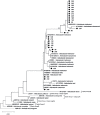Evidence of Helicobacter spp. in Saliva and Gastric Mucosa of Domestic Dogs in the Central Region of Rio Grande do Sul, Brazil
- PMID: 33575024
- PMCID: PMC7864744
- DOI: 10.1155/2021/8857231
Evidence of Helicobacter spp. in Saliva and Gastric Mucosa of Domestic Dogs in the Central Region of Rio Grande do Sul, Brazil
Abstract
Helicobacter pylori is a spiral-shaped bacterium, which plays a role in the aetiology of gastric diseases in humans. Non-H. pylori Helicobacter (NHPH) species naturally colonise the stomach of animals and also induce gastric lesions in humans, highlighting their zoonotic importance. We evaluated the gastric bacterial colonisation density and gastric lesions and sought to identify the main phylogenetic groups of the Helicobacter spp. obtained from dogs in the central region of Rio Grande do Sul, Brazil, with this study aiming to investigate the occurrence of Helicobacter spp. in saliva and gastric samples from these dogs. This study included 35 dogs and used analysis such as cytology, histopathology, PCR, rapid urease testing, and phylogenetic analysis. Of the dogs, 94.3% were positive for Helicobacter spp., and these bacteria were present in the stomach of 32 dogs and saliva of eight. Respectively, eight, 15, and nine dogs had mild, moderate, and severe colonisation. Lymphocytic-plasmacytic infiltrate was the main gastric lesion. However, the presence of Helicobacter and the density appeared to be unrelated to the gastric lesions. The samples possessed a high nucleotide identity with remarkably similar sequences among some of the species of NHPH such as H. heilmannii s.s., H. salomonis, H. felis, and H. bizzozeronii. The saliva of domestic dogs, even of those who appear clinically healthy, can cause Helicobacter infection in humans and other animals, with, in these dogs, increased density, occurrence rate, and predominance of NHPH of zoonotic importance being found in the stomach with a lower occurrence of Helicobacter spp. in the saliva.
Copyright © 2021 Daniel D. Guerra Segundo et al.
Conflict of interest statement
The authors declare no conflicts of interest.
Figures



Similar articles
-
[Detection of Helicobacter species in humans and their dog].Rev Fac Cien Med Univ Nac Cordoba. 2023 Sep 29;80(3):175-187. doi: 10.31053/1853.0605.v80.n3.36769. Rev Fac Cien Med Univ Nac Cordoba. 2023. PMID: 37773344 Free PMC article. Spanish.
-
Presence and significance of Helicobacter spp. in the gastric mucosa of Portuguese dogs.Gut Pathog. 2015 Apr 16;7:12. doi: 10.1186/s13099-015-0057-1. eCollection 2015. Gut Pathog. 2015. PMID: 25897328 Free PMC article.
-
Identification of non-Helicobacter pylori spiral organisms in gastric samples from humans, dogs, and cats.J Clin Microbiol. 2005 May;43(5):2256-60. doi: 10.1128/JCM.43.5.2256-2260.2005. J Clin Microbiol. 2005. PMID: 15872252 Free PMC article.
-
Non-Helicobacter pylori helicobacters detected in the stomach of humans comprise several naturally occurring Helicobacter species in animals.FEMS Immunol Med Microbiol. 2009 Apr;55(3):306-13. doi: 10.1111/j.1574-695X.2009.00535.x. Epub 2009 Feb 19. FEMS Immunol Med Microbiol. 2009. PMID: 19243435 Review.
-
Gastric and enterohepatic non-Helicobacter pylori Helicobacters.Helicobacter. 2013 Sep;18 Suppl 1:66-72. doi: 10.1111/hel.12072. Helicobacter. 2013. PMID: 24011248 Review.
Cited by
-
[Detection of Helicobacter species in humans and their dog].Rev Fac Cien Med Univ Nac Cordoba. 2023 Sep 29;80(3):175-187. doi: 10.31053/1853.0605.v80.n3.36769. Rev Fac Cien Med Univ Nac Cordoba. 2023. PMID: 37773344 Free PMC article. Spanish.
-
Gastric Helicobacter species associated with dogs, cats and pigs: significance for public and animal health.Vet Res. 2022 Jun 13;53(1):42. doi: 10.1186/s13567-022-01059-4. Vet Res. 2022. PMID: 35692057 Free PMC article. Review.
-
Presence of potentially novel Helicobacter pylori-like organisms in gastric samples from cats and dogs.Vet Res. 2023 Oct 17;54(1):93. doi: 10.1186/s13567-023-01223-4. Vet Res. 2023. PMID: 37849010 Free PMC article.
-
Helicobacter spp. in the Stomach of Cats: Successful Colonization and Absence of Relevant Histopathological Alterations Reveals High Adaptation to the Host Gastric Niche.Vet Sci. 2022 May 10;9(5):228. doi: 10.3390/vetsci9050228. Vet Sci. 2022. PMID: 35622756 Free PMC article.
References
LinkOut - more resources
Full Text Sources
Other Literature Sources
Miscellaneous

